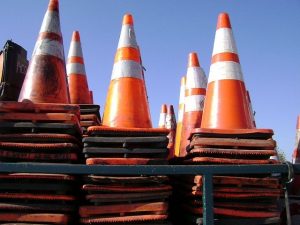Print a Sign-In Sheet | Spanish Version Coming Soon
The presence of safety hazards in the workplace are responsible for numerous injuries each year. Sometimes safety hazards lurk in plain sight and may be easily overlooked. It is important to be aware of potential hazards and take appropriate and timely steps to correct them.
It is equally as important to conduct regular and frequent safety inspections/walkthroughs of work facilities and/or job sites. In addition, it is a good idea to keep documentation of the facility/job site inspections. It is also imperative employees be trained on hazard recognition as well. Please see below for information on common workplace safety hazards to keep an eye out for. Effective hazard recognition will go a long way to preventing workplace injuries.
- Exit Ways
- Blocked exits
- Items stored over the lines in marked exit routes
- Exit lights out or not visible
- Exit doors without panic bars or takes more than two actions to open
- Fire Extinguishers
- Blocked extinguishers
- Un-mounted extinguishers
- Discharged extinguishers
- Damage to canister, hose, gauge, missing pin
- No annual inspection
- No monthly visual inspection
- No hydrostatic test (every 5 years)
- Lifting Slings
- Knots tied in slings (they can weaken the sling)
- Damage, fraying or cuts
- Damage to wire rope
- Bird caging to wire rope
- Discard damaged slings
- Breaker Boxes
- Blocked with storage (maintain 3’ clearance)
- Unlabeled breakers
- Missing knockout covers
- Missing panel/box covers
- General Electric
- Damaged outlets or missing faceplates
- Conduit not attached to junction boxes
- Exposed electrical wires
- Junction boxes missing covers
- Damage to insulation on power cords
- Plug separated from the power cord
- Ground prong missing from the plug
- Repairs to cords smaller than # 14 gauge
- Compressed Cylinders
- O2 and flammable gas stored together
- Flammable gas stored less than 20 feet apart
- Cylinders unsecured
- Cylinders stored in areas where vehicles, forklifts, and other heavy equipment may hit them
- Grinders and Portable Grinders
- Missing tongue guard and not adjusted to within ¼” to the wheel
- Missing work rest and not adjusted to within 1/8” of the wheel
- Missing safety guards
- Damaged, chipped, cracked grinding wheels
- Machine Guarding
- Missing safety guards
- Exposed pulleys, chains, moving parts
- Guarded pulleys, chains, moving parts, but only partially guarded
- Employees can reach hands or other body parts through, over, under or around a guard
- Point of operation unguarded
- Unguarded saw blades
KEMI does not assume liability for the content of information contained herein. Safety and health remain your responsibility. This information is to be used for informational purposes only and not intended to be exhaustive or a substitute for proper training, supervision or manufacturers’ instructions/recommendations. KEMI, by publication of this information, does not assume liability for damage or injury arising from reliance upon it. Compliance with this information is not a guarantee or warranty that you will be in conformity with any laws or regulations nor does it ensure the absolute safety of any person, place or object, including, but not limited to, you, your occupation, employees, customers or place of business.

